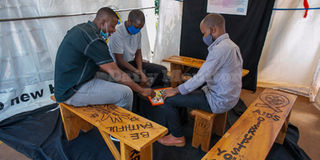Artistic twist to HIV awareness

Ssewanyana plays a game of Ludo with guests at the exhibition, depicting the everyday life of many urban youth. PHOTO/DENIS NSUBUGA.
What you need to know:
- The fight against HIV/Aids has not stopped and last week artist and Mak lecturer Robert Ssewanyana showcased some pieces of art to create further awareness of the disease using everyday objects used in urban life.
Artist Robert Ssewanyana’s latest work expands the conversation on the awareness of HIV/Aids. In his signature art form dubbed Applied Sculpture, Ssewanyana uses functional objects such as benches and beds to promote awareness on a scourge that has tormented Uganda’s urban youth over the years.
Messages on HIV/Aids prevention and treatment are aesthetically inscribed on the objects used in everyday life. The exhibition that took place at TASO Mulago on Wednesday last week, saw the artist who identifies as an Applied Sculptor, showcase works intended to stimulate the youth on their sex life.
Phrases such as ‘Be Faithful’ and ‘AIDS Disrupts Your Future’ are some of the engravings on benches placed at a Ludo game joint. This, according to Ssewanyana, is “effective in delivering awareness and prevention messages for local communities especially in busy trading centres where young people usually gather.”
The Research Dissertation Exhibition under the theme, ‘Art and creativity in HIV/Aids prevention and empowerment among young people’, was the culmination of Ssewanyana’s continued exploration into the subject of art as a tool of advocacy.

Guests view a sculpture of the HIV ward. PHOTO/DENIS NSUBUGA.
The lecturer at Makerere University’s School of Fine and Industrial Arts, engaged young artisans in industrial neighborhoods in Kampala, including Ndeeba, Lungujja and Bwaise. And in the 12 months of his research that ended in November 2020, artisans co-produced works in the context of HIV/Aids.
One of the works that fascinated viewers at the exhibition was titled Omutima Gwómulenzi Guli Wano Neeri, which is a carving on the headboard of a wooden bed. It depicts a heart with a dove in the middle.
According to Ssewanyana, it is a creation of 24-year-old artisan Izeyo Chan, who was depicting a love life typical in the society she lives in.
“The big heart is (symbolic of) the lovely boyfriend who has a darling described in the dove, but he will keep on getting concubines,” Ssewanyana said. The concubines are portrayed as silver cyprinid (mukene) engraved on the polls of the wooden bed.
The sexual network
“They destabilise the relationship, Chan says”, adding that the web grows into a sexual network. While the man heads for the mukene, the woman seeks solace from other men,” he explained.
Ssewanyana says they used the bed because it is traditionally known as marital space, so it can help send the messages.
“So the bed is very symbolic,” visual artist Lillian Nabulime said, adding: “Usually, people get infected while having sex on the bed, sometimes because they have forgotten about protection. When they have a bed like this, they will reflect more on the protection.”
Lillian Sande, a viewer at the exhibition, said the unconventional way of awareness is plausible because “for information to be prominent among the people, it should be developed from stuff they use every day.”
The event was attended by various dignitaries in the HIV/Aids advocacy fraternity, including Michael Etukoit, the executive director of TASO Uganda, who tackled the conservation on enhancing new local knowledge for empowerment, awareness and other challenges associated with the epidemic.
But, at least to the knowledge of the curators, the exhibition could not go without tackling one of the most prevalent health and social issues, Covid-19, and how it has affected human life. Art works addressing the pandemic were also showcased.
The piece, Abuser Within, is a portrayal of the undesirable situation brought about by the lockdown effected early last year. According to Ssewanyana, from research, the wooden sculpture of a house with a Covid-inspired lock peddle and nails on the sides depicts the life of many people in crowded industrial zones.
“Lockdown meant locking up with difficulties such as sexual abuse, gender-based violence, and economic hardships. How Covid-19 impacted livelihoods, people could not get health services, basically struggling to survive,” he explained, adding that it also overshadowed efforts to fight HIV/Aids.

The piece depicting life under lockdown. PHOTO/DENIS NSUBUGA.




